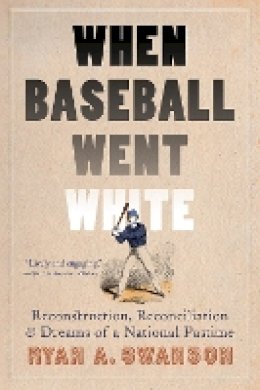
Stock image for illustration purposes only - book cover, edition or condition may vary.
When Baseball Went White: Reconstruction, Reconciliation, and Dreams of a National Pastime
Ryan A. Swanson
€ 40.87
FREE Delivery in Ireland
Description for When Baseball Went White: Reconstruction, Reconciliation, and Dreams of a National Pastime
Hardback. Tells the story of Jackie Robinson valiantly breaking baseball's color barrier in 1947. Focusing on Philadelphia, Washington DC, and Richmond - three cities with large African American populations and thriving baseball clubs, this book uncovers the origins of baseball's segregation and the mechanics of its implementation. Num Pages: 272 pages, 4 illustrations. BIC Classification: 1KBB; 3JH; HBJK; HBLL; WSJT. Category: (G) General (US: Trade). Dimension: 5817 x 3887 x 25. Weight in Grams: 553.
The story of Jackie Robinson valiantly breaking baseball’s color barrier in 1947 is one most Americans know. But less recognized is the fact that some seventy years earlier, following the Civil War, baseball was tenuously biracial and had the potential for a truly open game. How, then, did the game become so firmly segregated that it required a trailblazer like Robinson? The answer, Ryan A. Swanson suggests, has everything to do with the politics of “reconciliation” and a wish to avoid the issues of race that an integrated game necessarily raised.
The history of baseball during Reconstruction, as Swanson tells it, is a story of lost opportunities. Thomas Fitzgerald and Octavius Catto (a Philadelphia baseball tandem), for example, were poised to emerge as pioneers of integration in the 1860s. Instead, the desire to create a “national game”—professional and appealing to white northerners and southerners alike—trumped any movement toward civil rights. Focusing on Philadelphia, Washington DC, and Richmond—three cities with large Black populations and thriving baseball clubs—Swanson uncovers the origins of baseball’s segregation and the mechanics of its implementation.
An important piece of sports history, his work also offers a better understanding of Reconstruction, race, and segregation in America.
The history of baseball during Reconstruction, as Swanson tells it, is a story of lost opportunities. Thomas Fitzgerald and Octavius Catto (a Philadelphia baseball tandem), for example, were poised to emerge as pioneers of integration in the 1860s. Instead, the desire to create a “national game”—professional and appealing to white northerners and southerners alike—trumped any movement toward civil rights. Focusing on Philadelphia, Washington DC, and Richmond—three cities with large Black populations and thriving baseball clubs—Swanson uncovers the origins of baseball’s segregation and the mechanics of its implementation.
An important piece of sports history, his work also offers a better understanding of Reconstruction, race, and segregation in America.
Product Details
Format
Hardback
Publication date
2014
Publisher
University of Nebraska Press
Condition
New
Number of Pages
272
Place of Publication
Lincoln, United States
ISBN
9780803235212
SKU
V9780803235212
Shipping Time
Usually ships in 7 to 11 working days
Ref
99-1
About Ryan A. Swanson
Ryan A. Swanson is an associate professor and the director of the Lobo Scholars Program in the Honors College at the University of New Mexico. He is the author of The Strenuous Life: Theodore Roosevelt and the Making of the American Athlete.
Reviews for When Baseball Went White: Reconstruction, Reconciliation, and Dreams of a National Pastime
"A boon to scholars of both the early development of baseball and race relations after the Civil War."—Library Journal "When Baseball Went White is an intriguing, insightful, and provocative book that opens exciting possibilities for future researchers."—David Welky, Journal of Sport History "Lively and engaging."—Dain Tepoel, Sport in American History “Ryan Swanson's carefully researched and wonderfully nuanced study of baseball’s declining race relations during Reconstruction sheds considerable light on this oft-neglected topic. A must-read.”—Peter Morris, author of A Game of Inches and Level Playing Fields “Deeply researched and well written, Ryan A. Swanson’s When Baseball Went White carefully examines ‘the mechanics of segregation’ that racially cleansed organized baseball during Reconstruction and in the process helped the game become our ‘national pastime,’ at the expense of civil rights and racial justice. Swanson reveals, in fine detail, how a sport that would become a truly meaningful cultural practice and institution nevertheless became something less than it might have been.”—Daniel A. Nathan, president of the North American Society for Sport History and author of Saying It’s So: A Cultural History of the Black Sox Scandal
